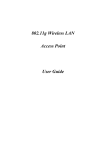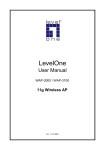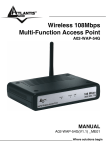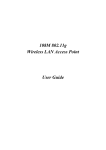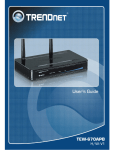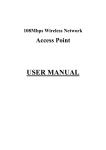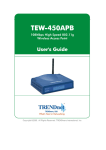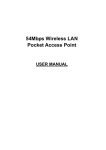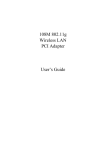Download Eusso Super-G User guide
Transcript
108Mbps Super-G Wireless LAN Access Point User Guide TM Regulatory notes and statements Wireless LAN, Health and Authorization for use Radio frequency electromagnetic energy is emitted from Wireless LAN devices. The energy levels of these emissions however are far much less than the electromagnetic energy emissions from wireless devices like for example mobile phones. Wireless LAN devices are safe for use frequency safety standards and recommendations. The use of Wireless LAN devices may be restricted in some situations or environments for example: ·On board of airplanes, or ·In an explosive environment, or ·In case the interference risk to other devices or services is perceived or identified as harmful In case the policy regarding the use of Wireless LAN devices in specific organizations or environments (e.g. airports, hospitals, chemical/oil/gas industrial plants, private buildings etc.) is not clear, please ask for authorization to use these devices prior to operating the equipment. Regulatory Information/disclaimers Installation and use of this Wireless LAN device must be in strict accordance with the instructions included in the user documentation provided with the product. Any changes or modifications made to this device that are not expressly approved by the manufacturer may void the user’s authority to operate the equipment. The Manufacturer is not responsible for any radio or television interference caused by unauthorized modification of this device, of the substitution or attachment. Manufacturer and its authorized resellers or distributors will assume no liability for any damage or violation of government regulations arising from failing to comply with these guidelines. USA-FCC (Federal Communications Commission) statement This device complies with Part 15 of FCC Rules. Operation is subject to the following two conditions: 1. This device may not cause interference, and 2. This device must accept any interference, including interference that may cause undesired operation of this device. i FCC Radio Frequency Exposure statement This Wireless LAN radio device has been evaluated under FCC Bulletin OET 65 and found compliant to the requirements as set forth in CFR 47 Sections 2.1091, 2.1093, and 15.247 (b) (4) addressing RF Exposure from radio frequency devices. The radiated output power of this Wireless LAN device is far below the FCC radio frequency exposure limits. Nevertheless, this device shall be used in such a manner that the potential for human contact during normal operation is minimized. When nearby persons has to be kept to ensure RF exposure compliance, in order to comply with RF exposure limits established in the ANSI C95.1 standards, the distance between the antennas and the user should not be less than 20 cm. FCC Interference Statement This equipment has been tested and found to comply with the limits for a Class B digital device, pursuant to Part 15 of the FCC Rules. These limits are designed to provide reasonable protection against harmful interference in a residential installation. This equipment generates, uses, and can radiate radio frequency energy. If not installed and used in accordance with the instructions, it may cause harmful interference to radio communications. However, there is no guarantee that interference will not occur in a particular installation. If this equipment does cause harmful interference to radio or television reception, which can be determined by turning the equipment off and on, the user is encouraged to try and correct the interference by one or more of the following measures: 1. Reorient or relocate the receiving antenna. 2. Increase the distance between the equipment and the receiver. 3. Connect the equipment to an outlet on a circuit different from that to which the receiver is connected. 4. Consult the dealer or an experienced radio/TV technician for help. Export restrictions This product or software contains encryption code that may not be exported or transferred from the US of Canada without an approved US Department of Commerce export license. ii Safety Information Your device contains a low power transmitter. When device is transmitted it sends out radio frequency (RF) signal. CAUTION: To maintain compliance with FCC’s RF exposure guidelines, this equipment should be installed and operated with minimum distance 20cm between the radiator and your body. Use on the supplied antenna. Unauthorized antenna, modification, or attachments could damage the transmitter and may violate FCC regulations. The antenna(s) used for this transmitter must be installed to provide a separation distance of at least 20 cm from all persons and must not be co-located or operating in conjunction with any other antenna or transmitter. CE Mark Warning This is a Class B product. In a domestic environment, this product may cause radio interference, in which case the user may be required to take adequate measures. Protection requirements for health and safety – Article 3.1a Testing for electric safety according to EN 60950 has been conducted. These are considered relevant and sufficient. Protection requirements for electromagnetic compatibility – Article 3.1b Testing for electromagnetic compatibility according to EN 301 489-1, EN 301 48917 and EN 55024 has been conducted. These are considered relevant and sufficient. Effective use of the radio spectrum – Article 3.2 Testing for radio test suites according to EN 300 328-2 has been conducted. These are considered relevant and sufficient. CE in which Countries where the product may be used freely: Germany, UK, Italy, Spain, Belgium, Netherlands, Portugal, Greece, Ireland, Denmark, Luxembourg, Austria, Finland, Sweden, Norway and Iceland. France: The use of other channels that the channel 10 through 13 is prohibited by law. iii TABLE OF CONTENT About This Guide...................................................................................................................................................................................... 1 Purpose ................................................................................................................................................................................................. 1 Overview of this User’s Guide.............................................................................................................................................................. 1 Unpacking and Setup ................................................................................................................................................................................ 3 Unpacking............................................................................................................................................................................................. 3 Setup ..................................................................................................................................................................................................... 3 Hardware Instalation................................................................................................................................................................................. 5 Front panel ............................................................................................................................................................................................ 5 Rear Panel ............................................................................................................................................................................................. 5 Hardware connections........................................................................................................................................................................... 6 Connect to the xDSL/Cable Modem or Switch/Hub......................................................................................................................... 6 Check the installation........................................................................................................................................................................ 6 Configuring the Wireless LAN Access Point ........................................................................................................................................... 7 Login to the Wireless AP through WLAN............................................................................................................................................ 7 Login..................................................................................................................................................................................................... 7 Main Screen of the Access Point .......................................................................................................................................................... 8 Wizard................................................................................................................................................................................................... 9 Status................................................................................................................................................................................................... 11 Basic Setting ....................................................................................................................................................................................... 12 IP Setting............................................................................................................................................................................................. 15 Advanced Setting ................................................................................................................................................................................ 16 Access Point Mode ......................................................................................................................................................................... 16 AP Client mode............................................................................................................................................................................... 17 Wireless Bridge mode..................................................................................................................................................................... 18 Multiple Bridge mode ..................................................................................................................................................................... 19 Repeater mode ................................................................................................................................................................................ 20 Security ............................................................................................................................................................................................... 22 Tools ................................................................................................................................................................................................... 23 Technical Specifications ......................................................................................................................................................................... 25 v ABOUT THIS GUIDE Congratulations on your purchase of this 108Mbps Super-G Wireless LAN Access Point. This manual helps to features the innovating wireless technology that can help you build a wireless network easily! This manual contains detailed instructions in operation of this product. Please keep this manual for future reference. With a WLAN Access Point, a mobile computer can share data with another mobile computer in a wireless way. Easy-to-use utilities are bundled with WLAN Access Point for configuration and monitoring purposes. WLAN networking can wirelessly transmit and receive data, minimizing the need for wired connections, at a speed of up to 108Mbps (Super-G mode). With WLAN networking, you can locate your PC wherever you want without wires and cables. WLAN networking provides users with an access to real-time information anywhere in their organization. The mobility provides productivity and service, which are not available under wired networks. Purpose This manual discusses how to install the WLAN Access Point. Overview of this User’s Guide Introduction. Describes the WLAN Access Point and its features. Unpacking and Setup. Helps you get started with the basic installation of the WLAN Access Point. Hardware Installation. Describes the LED indicators of the AP. Software Installation. Tells how to setup the driver and the utility setting. Technical Specifications. Lists the technical (general, physical and environmental) specifications of the WLAN Access Point. 1 UNPACKING AND SETUP This chapter provides unpacking and setup information for the Access Point. Unpacking Open the box of the Access Point and carefully unpack it. The box should contain the following items: One 108Mbps Super-GTM Wireless LAN Access Point One 2dBi dipole antenna One external power adapter One CD-Rom (User’s guide) If any item is found missing or damaged, please contact your local reseller for replacement. Setup The setup of the Wireless Access Point can be performed using the following steps: Locate an optimum location for the Wireless LAN Access Point (AP). The best place for your AP is usually the center of your wireless network, with line of sight to all of your mobile stations. Visually inspect the Ethernet RJ-45 port connector and make sure that it is fully plugged in to the system’s Ethernet switch/hub port. Fix the direction of the antennas. Try to place the AP in a position that can best cover your wireless network. Normally, the higher you place the antenna, the better the performance will be. The antenna’s position enhances the receiving sensitivity. Visually inspect if the Power Adapter was fully plugged to the device power jack. 3 HARDWARE INSTALATION Front panel The figure below shows the LED Indicator of the Wireless LAN Access Point. Power: This indicator lights green when the Access Point receives power. Otherwise, it turns off. WLAN: The indicator blinking green whiles the wireless LAN activity. LAN (Link/ACT): The indicator lights green when the LAN port is connected to an Ethernet network successful. Otherwise, the indicator blinking green while transmitting or receiving data on the Ethernet network. Rear Panel The figure below shows the rear panel of the Access Point Rear Panel 5 Ethernet port Ethernet port with 10/100Mbps Fast Ethernet connections, connect this port to switch/hub. Reset The Reset function is to reset the setting back to factory default setting, once you press the “RESET” button more than 5 seconds. DC Power Connect the Power Adapter DC plug to the AP’s power jack. Antenna One external 2dBi dipole antenna. Hardware connections Connect to the xDSL/Cable Modem or Switch/Hub 1. Plug in one end of the RJ45 network cable to the xDSL/Cable Modem or Switch/Hub Ethernet port. 2. Plug in the other end of the RJ45 network cable to the Wireless Access Point. Check the installation The LEDs of the Access Point are clearly visible and the status of the network link can be seen instantly: 1. With the power source on, once the device is connected, the Power, LAN and WLAN port LEDs will light up indicating a normal status. 2. If the LAN Port’s Link indicator does not light up then check the RJ-45 cable if it is firmly feed to the RJ45 port, while the LAN is link up to the Switch/Hub, the LAN port’s LED will light up. 6 CONFIGURING THE WIRELESS LAN ACCESS POINT The Wireless Access Point has a Web GUI interface for the configuration. The AP can be configured through the Web Browser. A network manager can manage, control and monitor the AP from the local LAN. This section indicates how to configure the AP to enable its functions. Login to the Wireless AP through WLAN Before configuring the Wireless AP through WLAN, make sure that the SSID, Channel and the WEP was set properly. The default setting of the Wireless AP that you will use: SSID: default Channel: 6 WEP Encryption: Disabled IP address: 192.168.1.1 Login Before you configure this device, note that when the AP is configured through an Ethernet connection, make sure the manager PC must be set on same the IP network. For example, when the default network address of the default IP address of the AP is 192.168.1.1, then the manager PC should be set at 192.168.1.x (where x is a number between 2 and 254), and the default subnet mask is 255.255.255.0. Open Internet Explorer 5.0 or above Web browser. Enter IP address http://192.168.1.1 (the factory-default IP address setting) to the address location. When there is a screen needs to enter the User name and Password, both of the default Username and Password is “admin” 7 Main Screen of the Access Point The screen will show the status of the AP when you login to the AP. There are seven main functions included in the top side of the main screen: Wizard, Status, Basic Setting, IP Setting, Advanced Setting, Security and Tools. Point the selections in the top side of the menu screen. 8 Wizard Setup wizard is provided as the part of the web configuration utility. User can simply follow the step-by-step process to get Access Point configuration ready to run in 4 easy steps by clicking on the “Wizard” button on the function menu. The following screen will appear. Please click “Next” to continue. Step 1: Set Password User can change the password and then click “Next” to continue. Step2: Set WLAN Connection Please type the name of SSID and select the Channel. Then, click “Next” to continue. 9 Step 3: Set WEP Encryption If user wants to enable WEP, please click “Enabled”. Then, select the key size of WEP encryption and enter the key value in the key text box. Please click “Next” to continue. Step 4: Restart The Setup wizard is now completed. The new settings will be effective after the Access Point restarted. Please click “Restart” to reboot the Access Point. If user does not want to make any changes, please click “exit” to quit without any changes. User also can go back to modify the setting by clicking “back”. 10 Status This page as below shows the following information. Firmware Version: Shows the current firmware version and released date code. LAN: Shows the Mac address, IP address (default: 192.168.1.1), Subnet Mask, Gateway Address. The current LAN traffic calculated in terms of number of packets sent and received by AP through wired connection is also displayed. Wireless: Shows the current SSID, the status of Encryption Function (Enable or Disable), the current using channel. The current wireless traffic calculated in terms of number of packets sent and received by AP through wireless communication is also displayed. View Log: Once clicked, the page will change to login page. The login page records every event and the time that it happens. User may clear the entries recorded in the log by clicking the “Clear Log” button, and refresh the screen to show the latest log entries by clicking the “Refresh” button. 11 Basic Setting This is the page allow user to change the access point settings. . AP Name: The name of the AP, which can be used to identify the Access Point among the all the Access Points in the wireless network. SSID: Service Set Identifier, which is a unique name shared among all clients and nodes in a wireless network. The SSID must be identical for each clients and nodes in the wireless network. Channel: The channel that AP will operate in. User can select the channel range from 1 to 11 for North America (FCC) domain, 1 to 13 for European (ETSI) domain and 1 to 14 for Japanese domain. Extended Range: When you enable this function, AP will reduce data rate with a long distance. Authentication Type: There are four options: Disable, WEP, WPA and WPA2. All of the WLAN nodes and hosts on the network must use the same authentication type. WEP Key: 1. Key type: Select the WEP key type for Open System or Shared Key; the Open System allows public access to the AP via wireless communications; the Shared Key requires the user to set a WEP key to exchange data with other wireless clients that have the same WEP key. 2. WEP Key length: Select the WEP key length for 64bits or 128 bits. 3. Key mode: Select the WEP key format for ASCII or HEX. 4. Key 1 ~ Key 4: Specify the WEP key value in key 1 ~ key 4. Press Apply button to save the new settings and the Access Point will be restart to activate the new settings. 12 Note: When the WEP security is enabled, all the wireless clients that wish to connect to the Access Point must also have WEP enabled with the identical WEP Key value entered. WPA-PSK / WPA2-PSK: If WPA-PSK or WPA2-PSK is selected, user needs to set the key in the passphrase field as the below screen. The key length should be 8 characters at least. 13 WPA / WPA2: If WPA or WPA2 is selected, the below screen is shown. Please set the length of the encryption key and the parameters for the RADIUS server. Encryption Key: Select the Encryption Key Length ranging from 64 or 128 Bits that you would like to use. RADIUS Server 1: Enter the IP address and the Port number to be used by the Primary Radius Server, enter the Shared Secret, which is used by the Radius Server. RADIUS Server 2: (optional) Enter the IP address and the Port number to be used by the Secondary Radius Server, enter the Shared Secret, which is used by the Radius Server. Press Apply button to save the new settings and the Access Point will be restart to activate the new settings. 14 IP Setting This page allows user to configure the IP and DHCP settings of the Access Point. The default IP address of this access point is 192.168.1.1 with the subnet mask of 255.255.255.0. User can type in other values for IP Address, Subnet Mask and Gateway and click “Apply” button for the changes to be effective. User can also set the Access Point to obtain the IP from a DHCP server, but it is not recommended. Select the option “Obtain IP Automatically” and click “Apply” button for the changes to be effective. DHCP Server: It is not recommended to enable the DHCP Server if user has a DHCP server running in LAN network because it probably will cause possible the conflict of IP assignment. Enable the DHCP server function by selecting the option “On”, and enter the IP range. DNS Server: When enabled the DHCP Server, enter IP address of the DNS server in the text boxes. Your ISP will provide you with this information. Click “Apply” for the changes to be effective 15 Advanced Setting This page contains configurations for advanced users, which the change reflects the wireless performance and operating modes. AP Mode: The WLAN AP supports five operation modes for Access Point, AP Client, Wireless Bridge, Multiple Bridge, and Repeater mode. Access Point Mode Configure the AP to Access Point mode; with this mode, WLAN clients can access LAN or other WLAN clients through this AP. AP mode application 16 AP Client mode Configure the AP to AP Client mode; the AP will be a wireless Ethernet adapter transforms any Ethernet-enabled devices to have the wireless function. AP Client mode application Remote AP SSID: Service Set Identifier, which is a unique name shared among all clients and nodes in a wireless network. The SSID must be identical for each clients and nodes in the wireless network. Site Survey: This button allows user to enable the Site Survey function to scan for the available wireless network (wireless clients and Access Points) and establish wireless communications with one. Selected one of them in list to establish communications and click “Connect” button. 17 WDS: Select the client mode connection method for WDS, Clone MAC or Proxy. WDS: Through this client mode AP, multiple users are allowed connecting to the wireless LAN network and with the users own MAC address. MAC Clone: Through this client mode AP, only single user is allowed connecting to the wireless LAN network and with the user own MAC address. Proxy: Multiple users are allowed connecting to the wireless LAN network through this client mode AP and with the AP own MAC address. Wireless Bridge mode Configure to the wireless bridge mode; these APs will be a LAN to LAN wireless Ethernet bridge between two separated Ethernet LAN segments. Bridge mode application Remote Bridge MAC: Enter the MAC address of the opposite AP here. Note: These two APs must using same wireless channel setting. 18 Multiple Bridge mode Configure to the multiple bridge mode; these APs will be a LAN to LAN wireless Ethernet bridge between two or more separated Ethernet LAN segments. Note: These Multiple Bridge APs must using same SSID setting. 19 Repeater mode Configure the AP to Repeater mode; the AP will be a wireless LAN repeater that will be extended the WLAN coverage range. Note: The SSID setting must same as remote AP. Remote AP SSID: Service Set Identifier, which is a unique name shared among all clients and nodes in a wireless network. The SSID must be identical for each clients and nodes in the wireless network. Site Survey: This button allows user to enable the Site Survey function to scan for the available wireless network (wireless clients and Access Points) and establish wireless communications with one. Selected one of them in list to establish communications and click “Connect” button. Beacon Interval: To set the period of time in milliseconds that AP sends out a beacon. Default is 100 milliseconds. RTS Threshold: RTS stands for “Request to Send”. This parameter controls what size data packet the low level RF protocol issues to an RTS packet. The default is 2346. Fragmentation Threshold: To set the number of bytes used for the fragmentation boundary for directed messages. Default is 2346 bytes. 20 DTIM Interval: This value indicates the interval of the Delivery Traffic Indication Message (DTIM). A DTIM field is a countdown field informing clients of the next window for listening to broadcast and multicast messages. When the access point has buffered broadcast or multicast messages for associated clients, it sends the next DTIM with a DTIM interval value. Access point clients hear the beacons and awaken to receive the broadcast and multicast messages. SSID Broadcast: While SSID Broadcast is enabled, all wireless clients will be able to communicate with the access point. For secure purpose, user may want to disable SSID broadcast to allow only those wireless clients with the AP SSID to communicate with the access point. TX Rates: Select one of the wireless communications transfer rates, measured in megabytes per second, based upon the speed of wireless adapters connected to the WLAN. CTS mode: None: Disable CTS function. Always: Regardless of wireless environment (11b or 11g), platform will always transfer 11b packet. Auto: AP soon detected the wireless environment and decided the transmission packet, either 11b or 11g 11g Only Mode: To setting the AP operation mode for 802.11g only or 802.11b/802.11g mix mode. Super G Mode: From the drop list, if you like to use Super-GTM to enhance the speed, there are three options on Super-GTM mode: Super G without turbo; Super G with Dynamic turbo and Super G with Static turbo. The turbo mode indicates the combination of two channels to enhance the throughput. Super G without turbo indicates that it is on Super G mode without the channel’s combination. Dynamic turbo is able to automatically detect if any ‘Super-GTM based’ product is available. If no, the connection is via ‘normal’ G. Static turbo means it will not go back to ‘normal’ G once it starts. Antenna transmit power: Adjust the power of the antenna transmission by selecting from the drop down list for full, half (-3dB), quarter (-6dB), eighth (-9dB) and min. Aging Interval: To limited STA connect timing. 21 Security This page is where user configures the security features supported by this Access Point. Password: Allow user to change the new login password. Here are the necessary steps: 1. Enter the new Administrator id in the “ Administrator id” field. 2. Enter the new password in the “AP Password New” field. 3. Enter the new password again in the “Confirm” field. 4. Click “Apply” MAC Filter: MAC Filter function controls the MAC of the network devices that are listed in this table for access authorization or denial. There have three choices: MAC Filter: Disable or enable the MAC Filter function Only allow PCs with MAC listed below to access device Only deny PCs with MAC listed below to access device The maximum number of MAC addresses that can be stored is 50. User can browse through the MAC address saved by selecting the MAC Filter List. For any changes made in the security page, click “Apply” for the changes to be effective. 22 Tools Four functions are provided in this page, Backup, Restore Settings, Restore default settings and Firmware Upgrade. Backup Settings: Click on “Backup” button, which will open a FileSave Dialog box, where user gets to save all the current settings and configurations to a file. Restore Settings: Click on the “Browse” button to open a FileOpen Dialog box, where user gets to select the file, which saves previous settings and configurations. Upon selecting the saved file, click “Restore” and complete the restore process when the access point re-operates after it restarts. Restore to default settings: Click on “Default” button to restore the access point back to its manufacture default settings. Firmware Upgrade: Click on the “Browse” button to open a FileOpen Dialog box, where gets to select the firmware file, which download from the web for the latest version. Upon selecting the firmware file, click “Upgrade” and complete the firmware upgrade process when the Access Point re-operates after it restarts. SNMP: Enable or disable the SNMP agent on the AP. System Location: Description the location of the AP. System Contact: Description the contact information for the person responsible for the AP. 23 Community: SNMP system name for exchanging SNMP community messages. The name can be used to limit SNMP messages passing through the network. The default name is “public”. Trap Receiver: Type the name of the destination PC that will receive trap messages. 24 TECHNICAL SPECIFICATIONS General Standards IEEE 802.11b IEEE 802.11g IEEE 802.3u 10/100BASE-TX Fast Ethernet Signal Type: DSSS (802.11b) OFDM (802.11g) Modulation: QPSK / BPSK / CCK / OFDM LED Indicators: Power, LAN (Link/Activity), WLAN (Link) Frequency 2412 MHz ~ 2462 MHz (FCC) 2412 MHz ~ 2472 MHz (ETSI) 2400 MHz ~ 2484 MHz (Japan) Channel 1 ~ 11 Channels (FCC) 1 ~ 13 Channels (ETSI) 1 ~ 14 Channels (Japan) Data Encryption: 64 bit / 128 bit WEP Encryption, WPA, WPA2, WPA-PSK, WPA2-PSK Data Transfer Rate Fast Ethernet: 10/100Mbps Wireless: Up to 54Mbps in 802.11g mode; up to 108Mbps in Super-GTM mode Receiver Sensitivity 54Mbps: Typical -70 dBm @10% PER 11Mbps: Typical -85 dBm @8% PER Transmit Power 802.11g: Minimum 13dBm typically 802.11b: Minimum 15dBm typically Transmission Range: Outdoor: 100~300M (depends on environment) Indoor: 50~100M (depends on environment) Network Cables 2-pair UTP/STP Cat. 3,4,5 (100 m) Interface 1 x 10/100Mbps RJ45 port Antenna: 1 x 2 dBi Dipole Antenna 25 Physical and Environmental DC inputs DC 7.5V /1A Temperature Operating: 0 ~ 40 oC, Storage: -10 ~ 70 oC Humidity Operating: 10% ~ 90%, Storage: 5% ~ 90% Dimensions 140 x 98 x 30 mm (W x H x D) without Antenna EMI: FCC Class B, CE Mark B, 26





























